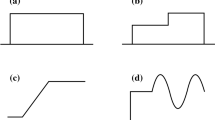Summary
The dynamic ranges of cochlear nerve fibres in cats were determined automatically and were related to the fibres' rates of spontaneous activity, in both pooled data and data from individual cochlear nerves. The dynamic range represents the range of levels of a tone at the characteristic frequency of the fibre evoking mean discharge rates between spontaneous and saturated activity.
In common with the findings of other investigators, the distribution of spontaneous discharge rates was bimodal. The total population could be divided into two sub-populations with spontaneous discharge rates above and below 15 spikes/s, respectively.
The mean dynamic range of fibres having spontaneous discharge rates in excess of 15 spikes/s, was 41 dB (±0.65 S.E.); that for fibres with rates below 15 spikes/s was 50 dB (±1.2 S.E.). While the distributions of dynamic ranges of the two populations overlapped, they were significantly different, and dynamic ranges in excess of 60 dB were only found in substantial numbers (23%) in the population having low spontanous discharge rates. Some of these were not saturated at the highest stimulus levels used.
Similar content being viewed by others
References
Evans EF (1972) The frequency response and other properties of single fibres in the guinea pig cochlear nerve. J Physiol (Lond) 226: 263–287
Evans EF (1970) Place and time coding of frequency in the peripheral auditory system; some physiological pros and cons. Audiology 17: 369–420
Evans EF (1979) Single unit studies of the mammalian auditory nerve. In: Beagley HA (ed) Auditory investigations. The scientific and technological basis, chapt 15, Oxford University Press, Oxford, pp 324–367
Kiang NY-s (1968) A survey of recent developments in the study of auditory physiology. Ann Otol Rhinol Laryngol 77: 656–675
Kiang NY-s, Liberman MC, Levine RA (1976) Auditory-nerve activity in cats exposed to ototoxic drugs and high-intensity sounds. Ann Otol Rhinol Laryngol 75: 752–769
Kiang NY-s, Moxon EC, Levine RA (1970) Auditory nerve activity in cats with normal and abnormal cochleas. In: Wolstenholme GEW, Knight J (eds) Sensorineural hearing loss. Churchill, London, pp 241–268
Kiang NY-s, Watenabe T, Thomas EC, Clarke LF (1965) Discharge patterns of single fibres in the cat's auditory nerve. (Research monograph), vol 35, MIT Press, Cambridge, MA
Kim DO, Molnar CE (1979) A population study of cochlear nerve fibres: Comparison of spatial distributions of average rate and phase-locking measures of responses to single tones. J Neurophysiol 42: 16–30
Liberman MC (1978) Auditory nerve responses from cats raised in a low-noise chamber. J Acoust Soc Am 63: 442–455
Nomoto M, Suga N, Katsuki Y (1964) Discharge pattern and inhibition of primary auditory nerve fibers in the monkey. J Neurophysiol 27: 768–787
Palmer AR, Evans EF (1979) On the peripheral coding of the level of individual frequency components of complex sounds at high sound levels. Exp Brain Res [Suppl] 2: 19–26
Palmer AR, Evans EF (1980) Cochlear fibre rate-intensity functions: no evidence for basilar membrane non-linearities. Hear Res 2: (in press)
Sachs MB, Abbas PJ (1974) Rate versus level functions for auditory-nerve fibers in cats: tone burst stimuli. J Acoust Soc Am 56: 1835–1847
Sachs MB, Young ED (1979) Encoding of steady-state vowels in the auditory nerve: Representation in terms of discharge rate. J Acoust Soc Am 66: 470–479
Author information
Authors and Affiliations
Rights and permissions
About this article
Cite this article
Evans, E.F., Palmer, A.R. Relationship between the dynamic range of cochlear nerve fibres and their spontaneous activity. Exp Brain Res 40, 115–118 (1980). https://doi.org/10.1007/BF00236671
Received:
Issue Date:
DOI: https://doi.org/10.1007/BF00236671



